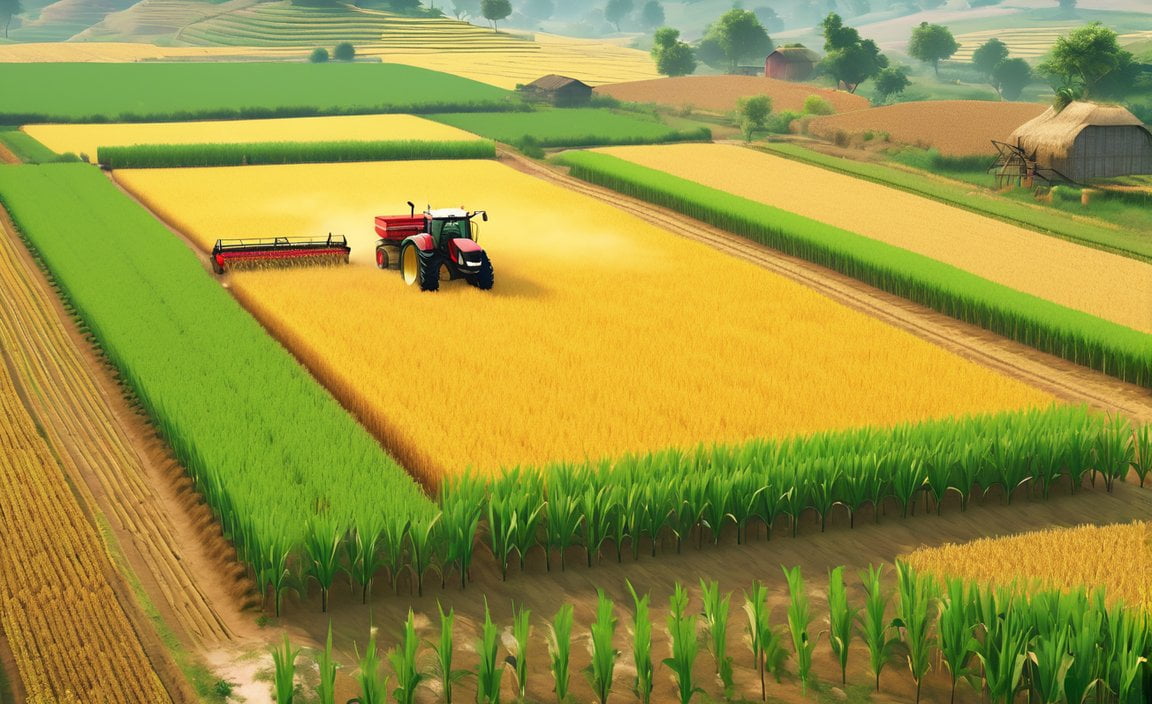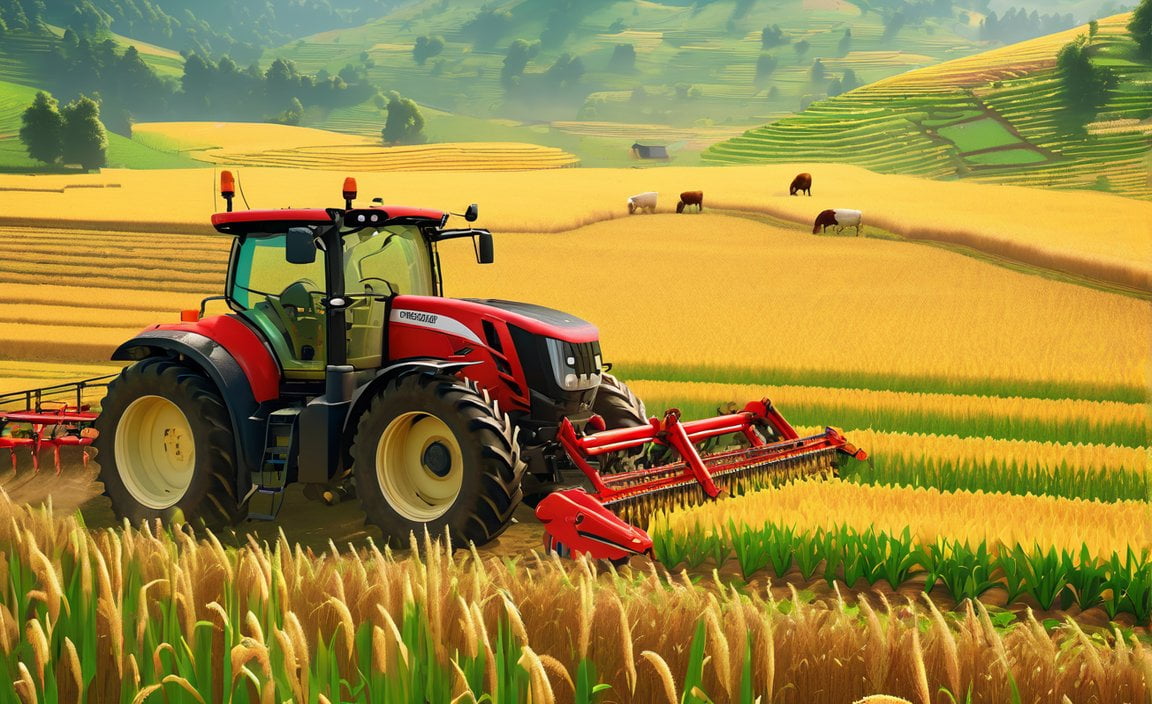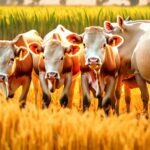Farming, the backbone of human civilization, has been the foundation of our sustenance and progress for millennia. From nurturing crops that nourish our bodies to shaping landscapes that sustain our planet, farming’s impact extends far beyond the fields it cultivates. Let’s delve into the 10 transformative benefits of farming that underpin our world:
1. Ensuring Food Security: The Bedrock of a Nourished World

Farming stands as the bedrock of a nourished world, playing a pivotal role in safeguarding food security, the cornerstone of a thriving society. Through the cultivation of a diverse array of crops, farmers tirelessly provide a steady supply of nutritious food, catering to the dietary needs of an ever-growing population. This unwavering commitment ensures that communities across the globe have access to essential sustenance, effectively preventing hunger and malnutrition.
1.1 Addressing Malnutrition: A Vital Role
Malnutrition, a severe condition arising from insufficient or imbalanced food intake, remains a prevalent global challenge. Farming directly addresses this issue by ensuring a consistent supply of nutrient-rich food sources. Farmers, through their dedication to crop diversity, cultivate a wide range of fruits, vegetables, grains, and legumes, each offering a unique blend of essential vitamins, minerals, and proteins. This diversity empowers individuals to make informed food choices, ensuring that their diets meet the recommended nutritional requirements.
1.2 Environmental Sustainability: A Harmonious Coexistence
Sustainable farming practices, such as crop rotation, organic pest control, and conservation tillage, not only enhance soil health and water quality but also promote biodiversity conservation. By embracing these practices, farmers foster a harmonious coexistence between agriculture and the environment, mitigating the negative impacts of conventional farming methods. This sustainable approach ensures that the land remains productive for future generations, safeguarding food security while preserving the delicate balance of ecosystems.
1.3 Nutritional Powerhouses: Crops that Nourish
The crops cultivated by farmers serve as nutritional powerhouses, providing a wealth of essential nutrients that support human health and well-being. Cereals, such as rice, wheat, and maize, form the basis of many diets, offering a rich source of carbohydrates, fiber, and B vitamins. Fruits and vegetables, brimming with antioxidants, vitamins, and minerals, play a crucial role in maintaining overall health and preventing chronic diseases. Legumes, such as beans, lentils, and peas, provide a valuable source of plant-based protein and fiber, essential components of a balanced diet.
1.4 Preserving Natural Resources: A Responsible Stewardship
Farming, when practiced sustainably, can contribute significantly to preserving natural resources. Sustainable farming practices, such as cover cropping and reduced tillage, enhance soil health, improving its ability to store water and reduce erosion. This, in turn, conserves precious freshwater resources, a critical element for crop production. Additionally, sustainable farming promotes biodiversity conservation, protecting the delicate balance of ecosystems that support agriculture.
1.5 Feeding the World: A Collective Effort
Farmers, the backbone of food production, are the unsung heroes who tirelessly work to feed the world. Their unwavering commitment ensures that communities across the globe have access to the sustenance they need to thrive. As the world’s population continues to grow, the role of farmers becomes increasingly crucial. Their dedication to sustainable practices, coupled with advancements in agricultural technology, holds the key to ensuring food security for generations to come.
2. Fueling Economic Development: The Engine of Progress
Farming serves as the lifeblood of economies, driving growth and prosperity across the globe. By producing a diverse array of raw materials, such as grains, fibers, and timber, farmers fuel various industries, generating employment opportunities, stimulating economic activity, and fostering international trade.
2.1 Providing Raw Materials: The Foundation of Industries
Agriculture provides the essential raw materials upon which countless industries are built. Grains, such as wheat, rice, and maize, form the basis of food processing, bakeries, and breweries. Fibers, such as cotton and wool, are the backbone of the textile industry, fueling clothing manufacturing and fashion trends. Timber, harvested from sustainably managed forests, supports the construction industry, furniture manufacturing, and paper production. These raw materials, produced by farmers, form the foundation of a thriving economy.
2.2 Generating Employment Opportunities: A Workforce that Powers Growth
Farming is a significant driver of employment, providing livelihoods for millions worldwide. From cultivating crops and raising livestock to processing agricultural products and transporting goods, the agricultural sector offers a multitude of employment opportunities. These jobs, ranging from skilled labor to management positions, contribute directly to economic growth and poverty reduction.
2.3 Stimulating Economic Activity: A Ripple Effect of Prosperity
The prosperity generated by farming extends far beyond the fields and into the broader economy. As farmers produce raw materials, industries that rely on these inputs experience growth and expansion. This ripple effect stimulates economic activity across various sectors, including manufacturing, transportation, retail, and services. The overall economic impact of farming is immense, contributing significantly to GDP growth and national prosperity.
2.4 Fostering International Trade: Connecting Nations and Markets
Farming plays a pivotal role in fostering international trade, connecting nations and promoting global commerce. Agricultural exports, such as grains, fruits, vegetables, and meat products, generate valuable foreign exchange earnings, contributing to national economies and strengthening international trade relationships. Farmers, through their dedication to producing high-quality agricultural products, are instrumental in expanding global trade networks and promoting mutual economic benefits.
2.5 Driving Innovation and Technology: A Sector Embracing Progress
The agricultural sector is not immune to the transformative power of innovation and technology. Farmers are increasingly adopting precision agriculture techniques, utilizing data analytics, robotics, and automation to optimize resource use, enhance productivity, and improve crop yields. These advancements drive efficiency, sustainability, and profitability within the agricultural sector, ensuring its continued contribution to economic growth.
In conclusion, farming stands as a cornerstone of economic development, fueling growth and prosperity through the production of raw materials, generation of employment opportunities, stimulation of economic activity, fostering of international trade, and embracing of innovation. The agricultural sector, driven by the dedication of farmers worldwide, remains an indispensable engine of progress, propelling nations towards a brighter economic future.
3. Preserving Natural Resources: A Symbiotic Relationship
Far from being an adversary to the environment, farming, when practiced sustainably, can be a powerful ally in environmental stewardship. Sustainable farming practices, such as crop rotation and organic pest control, not only enhance soil health and conserve water resources but also promote biodiversity conservation and climate change mitigation.
3.1 Enhancing Soil Health: A Foundation for Sustainable Productivity
Soil, the foundation of agriculture, is a precious and finite resource. Sustainable farming practices, such as crop rotation and cover cropping, work in harmony with natural processes to enhance soil health. Crop rotation, the practice of alternating different types of crops on the same land, helps control pests, diseases, and weeds, while also improving soil structure and nutrient content. Cover cropping, the planting of crops solely to protect and enrich the soil, further enhances soil health by preventing erosion, adding organic matter, and suppressing weeds.
3.2 Conserving Water Resources: A Precious Commodity
Water, the elixir of life, is an essential resource for agriculture. Sustainable farming practices, such as efficient irrigation techniques and water conservation measures, play a crucial role in preserving this precious commodity. Efficient irrigation techniques, such as drip irrigation and precision irrigation, deliver water directly to the roots of plants, minimizing evaporation and maximizing water use. Water conservation measures, such as rainwater harvesting and soil moisture monitoring, further reduce water consumption, ensuring that this vital resource is available for future generations.
3.3 Protecting Biodiversity: A Tapestry of Life
Biodiversity, the rich tapestry of life on Earth, is essential for maintaining healthy ecosystems and supporting sustainable agriculture. Sustainable farming practices, such as organic pest control and habitat conservation, promote biodiversity by reducing reliance on harmful chemicals and creating havens for pollinators and beneficial insects. Organic pest control methods, such as crop rotation and biological pest control, minimize the use of synthetic pesticides, protecting the delicate balance of ecosystems. Habitat conservation, the preservation of natural areas on farms, provides essential breeding and feeding grounds for pollinators and beneficial insects, ensuring the pollination of crops and the suppression of pests.
3.4 Mitigating Climate Change: Sequestering Carbon in the Soil
Climate change, a pressing global challenge, poses significant threats to agriculture. Sustainable farming practices, such as no-till farming and cover cropping, can help mitigate climate change by sequestering carbon in the soil. No-till farming, the practice of minimizing soil disturbance, reduces carbon dioxide emissions from the soil and enhances its ability to store carbon. Cover cropping, the planting of crops solely to protect and enrich the soil, also contributes to carbon sequestration by adding organic matter to the soil, increasing its carbon content.
In conclusion, sustainable farming practices, when embraced wholeheartedly, can transform agriculture into a powerful force for environmental stewardship. By enhancing soil health, conserving water resources, protecting biodiversity, and mitigating climate change, sustainable farming ensures the sustainability of our food systems and the preservation of our planet for future generations.
4. Empowering Rural Communities: The Backbone of Rural Resilience
Farming serves as the economic bedrock of rural communities, providing livelihoods, fostering a sense of identity, and playing a crucial role in maintaining rural infrastructure, preserving cultural traditions, and ensuring the vitality of these communities.
4.1 Providing Livelihoods: The Foundation for Rural Well-being
In rural areas across the globe, farming serves as the primary source of income for families, providing the financial means to meet basic needs, such as food, shelter, and education. Farmers, through their dedication to cultivating crops and raising livestock, generate revenue that supports local businesses, contributes to community development, and promotes overall rural well-being.
4.2 Fostering a Sense of Identity: Rooted in Tradition and Culture
Farming, deeply intertwined with rural traditions and culture, provides a strong sense of identity for individuals and communities. The passing down of agricultural knowledge and practices from one generation to the next fosters a deep connection to the land and a sense of belonging. This cultural heritage, rooted in farming practices, shapes rural identities and reinforces the unique character of rural communities.
4.3 Maintaining Rural Infrastructure: Vital Links for Connectivity
Farmers play a crucial role in maintaining the infrastructure that connects rural communities to the outside world. They contribute to the upkeep of roads, bridges, and irrigation systems, ensuring access to essential services like healthcare, education, and transportation. This infrastructure, vital for the economic and social well-being of rural communities, is often supported by the collective efforts of farmers.
4.4 Preserving Cultural Traditions: A Tapestry of Heritage
Farming is inextricably linked to the preservation of cultural traditions that define rural communities. The celebration of harvest festivals, the passing down of traditional cooking methods, and the use of local ingredients in cuisine all reflect the deep cultural heritage embedded in farming practices. Farmers, as custodians of these traditions, ensure that the rich cultural tapestry of rural communities remains vibrant and alive.
4.5 Ensuring the Vitality of Rural Communities: A Vibrant Future
The vitality of rural communities depends on the continued involvement of farmers in agriculture. Their dedication to sustainable practices, their contributions to infrastructure maintenance, and their role in preserving cultural heritage ensure that rural areas remain thriving hubs of economic activity, cultural vibrancy, and community resilience.
In conclusion, farming serves as the lifeblood of rural communities, providing livelihoods, fostering a sense of identity, maintaining infrastructure, preserving cultural traditions, and ensuring the vitality of these communities. Farmers, the backbone of rural resilience, play a pivotal role in shaping the future of rural areas, ensuring their continued prosperity and cultural richness.
5. Nurturing a Healthier Planet: A Symbiosis for Sustainability
Farming practices that promote soil health and biodiversity contribute significantly to a healthier planet. Healthy soils, teeming with life and organic matter, act as natural carbon sinks, mitigating climate change by sequestering carbon from the atmosphere. Thriving ecosystems, supported by sustainable agriculture, enhance air and water quality, benefiting all living organisms.
5.1 Sequestering Carbon: Healthy Soils as Climate Champions
Healthy soils, the foundation of sustainable agriculture, play a crucial role in mitigating climate change by sequestering carbon. As plants grow, they absorb carbon dioxide from the atmosphere through photosynthesis. When these plants become part of the soil through crop residues or cover crops, the carbon is stored within the soil organic matter. Sustainable farming practices, such as no-till farming and organic matter management, enhance soil organic matter content, increasing the soil’s ability to sequester carbon. By storing carbon in the soil, sustainable agriculture helps reduce greenhouse gas emissions and contributes to climate change mitigation.
5.2 Enhancing Air Quality: A Breath of Fresh Air
Sustainable farming practices contribute to cleaner air by reducing emissions of harmful pollutants. Conventional agricultural practices, such as excessive use of synthetic fertilizers and pesticides, can lead to the release of air pollutants, including ammonia, nitrogen oxides, and particulate matter. Sustainable farming practices, on the other hand, minimize the use of these chemicals, reducing air pollution and improving overall air quality. Additionally, cover crops and trees planted on farms act as natural air filters, capturing pollutants and releasing clean oxygen into the atmosphere.
5.3 Protecting Water Quality: A Treasure Worth Preserving
Sustainable farming practices play a vital role in protecting water quality. By reducing the use of synthetic fertilizers and pesticides, farmers minimize the risk of these chemicals contaminating groundwater and surface water sources. Sustainable irrigation techniques, such as drip irrigation and precision irrigation, conserve water resources and prevent runoff that can pollute water bodies. Additionally, planting riparian buffers along waterways helps filter pollutants and protect aquatic ecosystems.
5.4 Fostering Biodiversity: A Symphony of Life
Sustainable farming practices promote biodiversity conservation by creating habitats for a diverse range of species. By incorporating natural elements into farms, such as hedgerows, wildflower meadows, and ponds, farmers provide breeding grounds, food sources, and shelter for pollinators, beneficial insects, and wildlife. This thriving biodiversity enhances ecosystem services, such as pollination for crop production, pest control, and soil nutrient cycling.
In conclusion, sustainable farming practices, when embraced wholeheartedly, can transform agriculture into a powerful force for environmental stewardship. By promoting healthy soils, enhancing air and water quality, and fostering biodiversity, sustainable agriculture contributes to a healthier planet, ensuring the well-being of all living organisms and safeguarding the environment for future generations.
6. Promoting Sustainable Living: Embracing Harmony with Nature

Sustainable farming practices embody a harmonious coexistence between humans and the environment, forging a path towards a more sustainable future. By adopting eco-friendly techniques, farmers reduce their reliance on synthetic inputs, minimizing environmental degradation and fostering a symbiotic relationship with the natural world.
6.1 Reducing Reliance on Synthetic Inputs: A Paradigm Shift
Traditional agricultural practices have often relied heavily on synthetic fertilizers, pesticides, and herbicides to boost crop yields and control pests. However, these inputs have been linked to various environmental concerns, including soil and water contamination, harm to beneficial insects, and disruption of ecosystems. Sustainable farming embraces a paradigm shift, reducing reliance on these synthetic inputs and seeking alternative solutions that are both environmentally friendly and effective.
6.2 Embracing Natural Fertilizers: Nourishing Crops with Nature’s Bounty
Sustainable farming practices prioritize the use of natural fertilizers, such as compost, manure, and green manures, to replenish soil nutrients and enhance crop growth. These organic amendments not only provide essential nutrients for plants but also improve soil structure, increase water retention, and enhance soil biodiversity. By embracing natural fertilizers, farmers promote a healthier and more resilient ecosystem, reducing the need for synthetic inputs and their associated environmental impacts.
6.3 Employing Biological Pest Control: Harnessing Nature’s Defense Mechanisms
Sustainable farming seeks to control pests and diseases using natural methods, minimizing the use of harmful pesticides that can disrupt ecosystems and pose risks to human health. Biological pest control strategies rely on natural predators, parasites, and beneficial insects to control pest populations. By introducing these beneficial organisms to farms, farmers create a natural balance that keeps pests in check without resorting to synthetic chemicals.
6.4 Minimizing Environmental Impact: A Shared Responsibility
Sustainable farming practices extend beyond the fields, encompassing a holistic approach to environmental stewardship. Farmers adopt water conservation techniques, such as drip irrigation and precision irrigation, to minimize water usage and reduce the risk of water pollution. Additionally, they implement soil conservation practices, such as cover cropping and no-till farming, to prevent soil erosion and maintain soil health. By adopting these practices, farmers minimize their environmental impact, ensuring that agriculture contributes to a more sustainable future.
In conclusion, sustainable farming practices demonstrate a commitment to environmental stewardship and a harmonious coexistence between humans and nature. By reducing reliance on synthetic inputs, embracing natural alternatives, and minimizing environmental impact, sustainable farming paves the way for a more sustainable future, ensuring a healthy planet for generations to come.
7. Fostering Innovation and Technology: Advancing Agriculture in the Digital Age
Farming, a cornerstone of human civilization, is not immune to the transformative power of innovation and technological advancements. Today’s farmers are embracing precision agriculture, a data-driven approach that utilizes sophisticated tools and techniques to optimize resource use, enhance crop yields, and ensure a sustainable food supply for a growing population.
7.1 Embracing Precision Agriculture: Data-Driven Decisions for Sustainable Productivity
Precision agriculture revolutionizes farming practices by harnessing the power of data analytics, robotics, and automation. Farmers, equipped with sensors, GPS technology, and advanced software, can gather real-time data on soil conditions, crop health, and weather patterns. This data-driven approach allows for precise monitoring of crop growth and resource allocation, enabling farmers to make informed decisions that optimize resource use, minimize waste, and maximize yields.
7.2 Optimizing Resource Use: Conserving Precious Inputs
Precision agriculture promotes efficient resource utilization, conserving precious inputs such as water, fertilizers, and pesticides. By analyzing soil moisture levels and crop nutrient needs, farmers can precisely tailor irrigation and fertilization schedules, ensuring that crops receive the optimal amount of resources without overapplication. This targeted approach minimizes waste, reduces environmental impact, and promotes sustainable agricultural practices.
7.3 Enhancing Crop Yields: Nourishing a Growing Population
Precision agriculture contributes to enhanced crop yields, ensuring that farmers can meet the demands of a growing population. By analyzing data on plant health, nutrient requirements, and environmental factors, farmers can identify and address potential yield-limiting factors, such as pests, diseases, or nutrient deficiencies. This proactive approach optimizes plant growth and maximizes yields, ensuring a sustainable food supply for the future.
7.4 Harnessing Robotics for Precision Tasks
Robotics is playing an increasingly important role in precision agriculture, automating labor-intensive tasks and enhancing efficiency. Robotic platforms can perform tasks such as weeding, harvesting, and sorting crops, reducing the need for manual labor and improving precision. This automation not only increases productivity but also alleviates labor shortages and reduces the risk of human error, ensuring a consistent and high-quality food supply.
7.5 Embracing Innovation for a Sustainable Future
Farming, driven by innovation and technological advancements, is poised to play a pivotal role in addressing the challenges of a growing population and a changing climate. Precision agriculture, with its data-driven approach and resource-efficient practices, offers a promising path towards sustainable food production. As farmers continue to embrace innovation and technology, agriculture can transform into a force for environmental stewardship and a guarantor of food security for generations to come.
8. Preserving Cultural Heritage: A Tapestry of Traditions Woven Through Time
Farming practices, deeply intertwined with cultural traditions, serve as a testament to the enduring legacy of human ingenuity and adaptation. From cultivating unique crop varieties to employing time-honored cultivation techniques, farmers across the globe have preserved the rich tapestry of human heritage, connecting us to our past and shaping our future.
8.1 Cultivating Heirloom Varieties: A Legacy of Taste and Resilience
Heirloom crops, passed down through generations, embody the rich diversity and resilience of agricultural heritage. These varieties, often carefully selected for their unique flavors, adaptability to local conditions, and resistance to pests and diseases, represent a treasure trove of genetic diversity. By cultivating heirloom crops, farmers preserve not only culinary traditions but also a vital reservoir of genetic diversity that could prove invaluable in adapting to future climate challenges.
8.2 Embracing Traditional Cultivation Techniques: A Harmony with Nature
Traditional cultivation techniques, honed over centuries of experience and observation, embody a harmonious coexistence between humans and the natural world. Farmers, guided by ancestral wisdom, have developed practices that promote soil health, conserve water resources, and maintain ecological balance. These techniques, such as crop rotation, cover cropping, and organic pest control, stand in stark contrast to modern intensive agricultural practices that often rely on synthetic inputs and monoculture systems.
8.3 Celebrating Agricultural Cycles: Festivals that Honor the Land
Agricultural festivals, deeply rooted in local customs and beliefs, serve as vibrant expressions of cultural heritage, honoring the rhythms of the land and the interconnectedness of all living things. These celebrations, often coinciding with key stages of the agricultural cycle, bring communities together, fostering a sense of shared identity and appreciation for the land’s bounty. Through music, dance, and communal rituals, these festivals pay tribute to the farmers’ role in sustaining life and reaffirm the enduring bond between humans and the natural world.
8.4 Passing Down Agricultural Knowledge: A Legacy for Future Generations
The transmission of agricultural knowledge, passed down through generations, ensures the continuity of cultural heritage and the preservation of traditional farming practices. Within families and communities, farmers impart their wisdom and skills to younger generations, teaching them how to read the land, interpret weather patterns, and cultivate crops in harmony with nature. This intergenerational transfer of knowledge safeguards the rich tapestry of agricultural heritage, ensuring that traditional practices continue to thrive alongside modern advancements.
8.5 Preserving Culinary Traditions: Flavors that Reflect Culture
Culinary traditions, deeply intertwined with agricultural practices, reflect the unique cultural heritage of each region. The ingredients, cooking methods, and flavors associated with traditional dishes embody the ingenuity and resourcefulness of generations of farmers and cooks. By preserving these culinary traditions, communities not only safeguard their cultural identity but also ensure the continued transmission of valuable knowledge about food preservation, nutrition, and the connection between food and culture.
In conclusion, farming practices, deeply intertwined with cultural traditions, serve as a powerful testament to the enduring legacy of human ingenuity and adaptation. Through the cultivation of heirloom varieties, the preservation of traditional techniques, the celebration of agricultural cycles, the transmission of knowledge, and the preservation of culinary traditions, farmers play a crucial role in safeguarding the rich tapestry of human heritage, connecting us to our past and shaping a more sustainable and culturally vibrant future.
9. Inspiring Future Generations: Cultivating Stewards for a Sustainable World
Farming, with its inherent connection to the natural world and the cycle of life, offers a unique opportunity to inspire future generations and instill in them a deep sense of environmental responsibility. Engaging children in farm activities, from planting seeds to tending to crops, fosters an appreciation for the origins of our food, the delicate balance of ecosystems, and the importance of sustainable practices for a thriving planet.
9.1 Connecting with Nature: Nurturing a Lifelong Bond
Farms, with their diverse landscapes, abundant wildlife, and hands-on activities, provide an immersive environment for children to connect with nature on a personal level. Through firsthand experiences, children can observe the intricate relationships between plants, animals, and the environment, fostering a sense of wonder and appreciation for the natural world. This early connection to nature lays the foundation for a lifelong commitment to environmental stewardship.
9.2 Appreciating Food Origins: Understanding the Journey from Farm to Table
Engaging children in farm activities, such as harvesting crops, preparing meals, and participating in farm-to-table experiences, cultivates an understanding of the journey food takes from farm to table. Children gain a deeper appreciation for the hard work and dedication of farmers, the challenges and rewards of agriculture, and the importance of making informed food choices. This understanding fosters a sense of gratitude for the food we consume and encourages mindful eating habits.
9.3 Embracing Sustainable Practices: Nurturing a Responsible Future
Farms, when managed sustainably, serve as living laboratories where children can witness firsthand the implementation of eco-friendly practices. Through hands-on activities, such as composting, rainwater harvesting, and organic pest control, children learn about the importance of conserving resources, protecting biodiversity, and maintaining a healthy ecosystem. These experiences instill in them a sense of responsibility for the environment and empower them to make sustainable choices in their daily lives.
9.4 Cultivating Future Stewards: Inspiring a Generation of Changemakers
By engaging children in farm activities and immersing them in the world of sustainable agriculture, we are nurturing a generation of stewards who will be equipped to lead the way towards a more sustainable future. These children, inspired by the interconnectedness of life and the importance of environmental responsibility, will become advocates for sustainable practices, innovators in green technologies, and guardians of our planet’s precious resources.
In conclusion, farming offers a powerful platform for inspiring future generations and cultivating a sense of environmental stewardship. By connecting children with nature, fostering an appreciation for the origins of our food, and promoting sustainable practices, we empower them to become responsible citizens and agents of change, shaping a world that is both sustainable and ecologically balanced.
10. Cultivating a Brighter Future: Where Food, Planet, and Prosperity Intertwine
As we stand at the crossroads of a rapidly changing world, farming emerges as a beacon of hope, a sector with the potential to illuminate a brighter future where food security, environmental sustainability, and economic prosperity go hand in hand. It is a future where humanity thrives in harmony with nature, where the bounty of the land is shared equitably, and where the tireless efforts of farmers are recognized and rewarded.
10.1 Embracing Sustainable Practices: A Symbiosis for a Sustainable World
The path to a brighter future is paved with sustainable agricultural practices, a paradigm shift that prioritizes the health of the planet over short-term gains. Sustainable farming techniques, such as crop rotation, organic pest control, and conservation tillage, not only enhance soil health and protect biodiversity but also mitigate climate change by sequestering carbon in the soil. By embracing these practices, farmers become custodians of our planet, ensuring that future generations inherit a fertile and resilient Earth.
10.2 Supporting Local Farmers: Nurturing a Thriving Rural Economy
Supporting local farmers is an investment in our collective future. By choosing locally grown produce, we not only reduce the environmental impact of long-distance transportation but also strengthen the economic fabric of our communities. Local farmers, the backbone of rural economies, play a vital role in preserving cultural heritage, maintaining rural infrastructure, and providing employment opportunities. By supporting their livelihoods, we ensure the vitality of rural communities and foster a more equitable distribution of wealth.
10.3 Valuing the Bounty of the Land: A Legacy of Abundance
The bounty of the land is not merely a commodity; it is a testament to the interconnectedness of life, a symbol of our dependence on nature’s generosity. By valuing the land and its produce, we foster a culture of gratitude, appreciation, and respect for the natural world. We recognize that food is not just sustenance but a cultural cornerstone, a source of nourishment for both body and soul.
10.4 Farming: A Way of Life, A Cornerstone of Civilization
Farming is more than just an occupation; it is a way of life, a deeply ingrained thread in the tapestry of human civilization. For millennia, farmers have been the stewards of the land, nurturing the seeds of life and ensuring the continuity of our food supply. Their dedication, resilience, and deep connection to the natural world form the bedrock of our societies.
10.5 A Promise of a Brighter Tomorrow: A Collective Responsibility
The promise of a brighter future lies in our collective commitment to sustainable agriculture, fair trade practices, and a renewed appreciation for the land and its bounty. By empowering farmers, supporting local economies, and valuing the origins of our food, we can cultivate a world where food security, environmental sustainability, and economic prosperity are not mutually exclusive but rather intertwined strands of a harmonious future.
As we contemplate the road ahead, let us remember that farming is not merely a means to an end; it is a journey of co-creation with nature, a testament to human ingenuity, and a promise of a brighter tomorrow. By honoring the land, cherishing its bounty, and supporting the tireless efforts of farmers, we can cultivate a world where food, planet, and prosperity go hand in hand, ensuring a legacy of abundance and resilience for generations to come.
- Explore the incredible benefits of plants and how they contribute to a healthier environment.
- Learn about the numerous advantages of plants to humans and how they enhance our well-being in various ways.
FAQ
Q1: What are the 10 transformative benefits of farming?
A1: Farming is a multifaceted endeavor that underpins our society’s well-being. It provides us with nourishment, fuels economic growth, safeguards natural resources, and fosters sustainable living practices. Here are the 10 transformative benefits of farming:
- Ensures Food Security: Farming is the foundation of food security, providing a steady supply of nutritious food for a growing population.
- Supports Economic Development: Farming serves as the lifeblood of economies, generating employment opportunities, stimulating trade, and providing raw materials for various industries.
- Preserves Natural Resources: Sustainable farming practices enhance soil health, conserve water resources, protect biodiversity, and mitigate climate change.
- Empowers Rural Communities: Farming is the economic backbone of rural communities, providing livelihoods, fostering cultural identity, and maintaining infrastructure.
- Nurturing a Healthier Planet: Sustainable farming promotes soil health, enhances air and water quality, and supports thriving ecosystems.
- Promoting Sustainable Living: Sustainable farming practices reduce reliance on synthetic inputs, minimizing environmental degradation and promoting a more sustainable future.
- Fostering Innovation and Technology: Farming embraces innovation, utilizing precision agriculture, data analytics, and robotics to optimize resource use and enhance productivity.
- Preserving Cultural Heritage: Farming practices are deeply intertwined with cultural traditions, preserving rich heritage and connecting us to our past.
- Inspiring Future Generations: Engaging children in farm activities fosters an appreciation for food origins and the importance of sustainable practices.
- Cultivating a Brighter Future: Farming holds the key to a sustainable future, ensuring food security, environmental harmony, and economic prosperity.
Q2: How does farming contribute to food security?
A2: Farming plays a pivotal role in ensuring food security at a national and global level. By cultivating a diverse array of crops, farmers provide a steady supply of nutritious food that meets the dietary needs of a growing population. This prevents hunger, malnutrition, and food shortages.
Q3: What is the economic impact of farming?
A3: Farming is a significant driver of economic growth and development. It generates employment opportunities in various sectors, including agriculture, food processing, transportation, and retail. Farming also provides raw materials for industries like textiles, biofuels, and pharmaceuticals.
Q4: How does farming contribute to environmental sustainability?
A4: Sustainable farming practices, such as crop rotation, organic pest control, and conservation tillage, enhance soil health, improve water quality, protect biodiversity, and mitigate climate change. Sustainable farming promotes a harmonious coexistence between agriculture and the environment.
Q5: What are the benefits of farming for rural communities?
A5: Farming serves as the economic bedrock of rural communities, providing livelihoods, fostering a sense of identity, and maintaining infrastructure. Farmers play a crucial role in preserving cultural traditions, promoting community development, and ensuring the vitality of rural areas.
- Mastering Leader in Spanish: The Complete Guide - April 19, 2025
- Uncovering Surprising Parallels: England Size Compared to US States - April 19, 2025
- Old Mexico Map: Border Shifts 1821-1857 - April 19, 2025
















